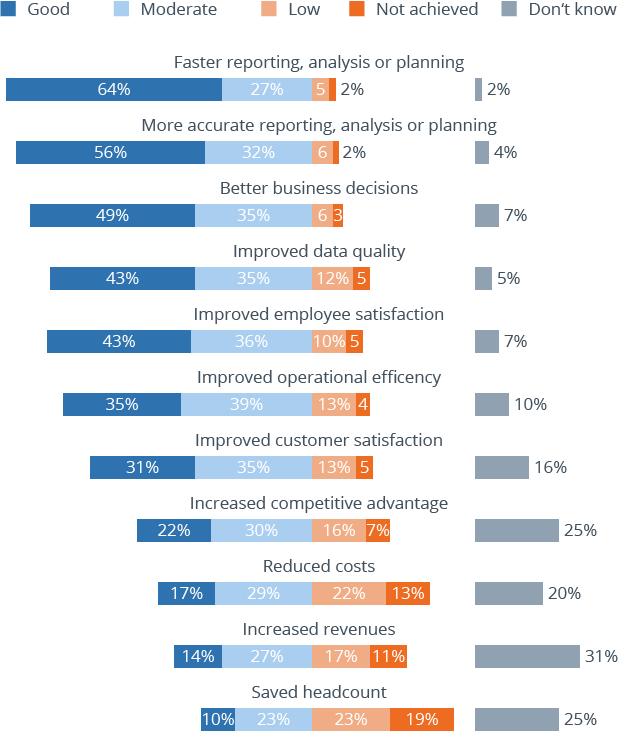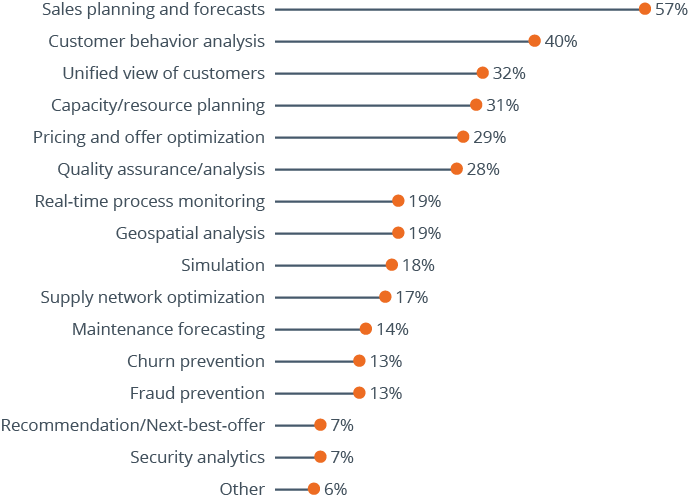BI Tools Need to Turn Data into Insights and Action
There are many reasons why organizations adopt business intelligence and analytics tools, and many ways these solutions are put to work to benefit the organization. All projects, however, have the common goal to use business intelligence software to turn data into insights and action.
As the primary competitive advantage business intelligence should deliver an increase in the understanding of the forces shaping markets and businesses, and help companies to act on that knowledge.
Ultimately, the hope is to be able to outsmart and out-deliver competitors, while proactively addressing customer needs.

Benefits and Advantages of Business Intelligence Systems
But do organizations meet this goal? To find out what kind of benefits business intelligence delivers in the real-world, we asked over 2,600 business intelligence users to provide us with insights on this topic.
Respondents were given a list of some of the potential benefits of business intelligence and were asked to indicate to what level they had achieved those benefits with BI:
- Faster reporting, analysis or planning
- More accurate reporting, analysis or planning
- Better business decisions
- Improved data quality
- Improved employee satisfaction
- Improved operational efficiency
- Improved customer satisfaction
- Increased competitive advantage
- Reduced costs
- Increased revenues
- Saved headcount
The following chart shows where BI software really helps companies.
The chart ranks the desired benefits from BI tools in order of frequency.
Above all else, BI and IT managers see their tools and platforms as a means to deliver faster and more accurate information to decision-makers. Faster and more accurate reporting, analysis or planning; better business decisions; improved employee satisfaction and improved data quality top the list.
Benefits achieved least frequently include reducing costs, increasing revenues and reducing IT headcount. With growing efforts to monetize data by improving commercial offerings, we might see the “increased revenues” outcome rising in frequency in the future.

Where Are BI Investments Being Applied to Gain Competitive Advantage
For years, organizations adopted BI and analytics technologies to achieve greater efficiency from business intelligence. With BI accessibility still limited due to license restrictions or product fit, companies have not yet conquered these early goals.
Despite this, many organizations are moving ahead on a new wave of business intelligence initiatives focused on predicting where to best steer the business. Because the folks responsible for steering the company primarily work in marketing and product development, these departments will gain influence in prioritizing requirements and selecting BI products.
Therefore, it comes as no surprise that results from The BI Survey 16 indicate a broadening scope in the vision and goals for current business intelligence investments.
Though reporting and dashboard capabilities remain core staples of a BI portfolio, this rising wave of BI investments is aiming for exploration involving new data types and new sources, including integration within companies’ commercial offerings. These product and market-driven projects need to extract insights so companies can outsmart the competition and over-deliver on product and service expectations.
Unlike traditional BI projects that mine internal data from enterprise resource planning (ERP) systems and data warehouses, many of today’s current BI projects taking place within sales and marketing require external data such as maps, social data, or even historical weather readings. Success in gaining new insights here requires BI software that allows functional users to bring new data sources together in different ways.
The chart below provides a snapshot of the solution areas where 2,220 survey respondents are applying their BI investment resources. One thing is clear: areas such as accounting and finance are more or less under control, so companies are moving to other parts of the enterprise and the top areas now involve gaining a better understanding of the customer, market, and competitive dynamics.
Want to rate your BI and analytics software?
Share your experience in the world‘s largest and most comprehensive survey of BI software users
Take part in The BI & Analytics Survey
User Satisfaction with the Business Intelligence Project Experience
BI projects can get complex. Smooth deployment and ongoing operations require the participation of the vendor, users, information security/compliance specialists, and even help desk support personnel.
The good news is that more business intelligence leaders increasingly leverage agile methodologies to achieve incremental benefits from BI rather than a big bang two or three risky years later.
When combined with business intelligence tools offering more self-service BI features, we see shrinking overall rollout times.
That said, issues like data quality, governance and lack of resources persist, which accounts for over a third of serious problems encountered by business users. The following chart provides a broader picture of how projects performed on various measures.



